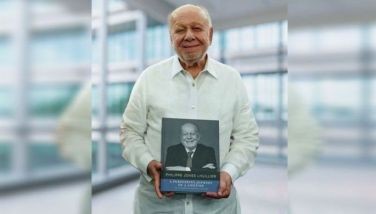Coconut and Oil Palm: Competition or complementation?
March 24, 2002 | 12:00am
President Arroyo’s recent land deal with Malaysian oil palm investors raises fear among coconut farmers that oil palm would directly compete with coconut in the Philippines. In spite of government assurance, they say there will be more pain than gain in this enterprise.
Not true! Say government agriculture officials. Instead of competing with each other, the two agricultural enterprises will actually complement each other.
Explains Agriculture Secretary Leonardo Q. Montemayor: "Oil palm plantation development will — we have no doubt about it — provide farmers, investors, the agricultural community and the country more advantages than perceived economic dislocations. We are looking at complementation and diversification. We see farmers deciding on better crops to plant where they could earn regular and higher incomes."
Based on import payments for palm oil and palm kernel oil from 1992 to 2000, the country is bound to generate foreign exchange savings of P1,020 million ($20 million). Domestic requirement for palm oil averaged at 94,5000 metric tons since 1992 of which 57.5 percent came from local production with the balance being filled up by imports.
Importation between 1992 and 2000 ranged from a low of 27,200 metric tons to a high of 56,000 tons in 2000. Biggest supplier to the Philippines is Malaysia with China, Indonesia and Singapore supplying the smaller volumes.
Many voices are raised in doubt, however. Among them, the Philippine Peasant Institute (PPI) which opposed the establishments of oil palm plantations in Mindanao. PPI executive director Romeo Royandoyan laments the fact that "the plan promotes plantation-type agriculture that would result in the reconsolidation of large private agricultural lands. In effect, this would turn back the government’s agrarian reform program and its agricultural modernization program which are supposed to spearhead the growth and productivity of small farms.
"Moreover, instead of parceling and distributing land to agrarian reform beneficiaries (ARBs), the government is stoking leaseback arrangements which run counter to the spirit and intent of agrarian reform.
Although the farmers were made to agree with the leaseback arrangement with a contract of seven years which later was extended to 25 years, now they are saying they are unhappy with the minimal benefits accruing to them which could easily be wiped out by possible inflation.
For his part, Luis Lorenzo Jr., presidential adviser on job generation and concurrently chairman of the Mindanao Peace and Development Council allays the misplaced fears of the country’s coconut farmers, especially those in Mindanao.
"Let us remove our misgivings. Mindanao palm oil will never replace nor displace coconut farms. On the social side, coconut helps farmers earn additional incomes as they can intercrop. Coconut plantation also allows families to build their nipa huts (bahay-kubo) underneath the trees. This is not possible for palm oil. On the other hand, coconut provides food for farmers — the meat and juice satisfy their needs during difficult times. Oil palm, on the other hand, is not edible except when used as cooking oil.
Industry experts estimate that in the next 10 years, demand for palm oil will rise considerably. Malaysia, the world’s top producer of palm oil is naturally looking for large farms outside its borders to expand production and satisfy world demand. The plant is suited in regions with evenly distributed rainfall and moderate climate. Hence, the ideal site is Mindanao. To this day, almost all of the more than 20,000 hectares planted to oil palms are in Mindanao — with 1,800 hectares in Bohol — especially the former forested areas of Agusan.
Lorenzo further explains that: "World demand for coconut oil, likewise, is also expected to expand due to the growing health consciousness of consumers in Europe and North America, where vegetable oil is preferred to animal fats. Palm oil cannot steal this market segment from us. Unlike coconut, oil palm has no other uses but for cooking.
"Palm oil (CPO), though has distinct advantage over coconut oil (CNO) in their prices. Thus, even if our coconut oil has a quality advantage, fast food chains like Jollibee, McDonald’s, Tropical Hut, Cindy’s Wendy’s KFC and other burger stores using tons of cooking oil for French fries, fried chickens, burgers etc. would naturally use the lower-priced CPO. Last year alone, the price differential between CNO and CPO is roughly P19,000 ($118) per ton, in favor of the former. On average, CNO is about P5,050 ($99) more expensive than CPO."
Philippine Coconut Authority Administrator (PCA) Danilo Coronacion advices that "the difference in prices should tell us that other options other than cooking oil are there. To survive in the next millennium, what Mindanao coconut farmers need is to move away from cooking oil business towards the high-end market segment for processing of food items, feeds, pharmaceuticals, confectionaries and cosmetics. Our coconut oil has no serious competition along these lines," Coronacion claims. We use almost half of our palm oil import for fish canning. Moving into the high-end segment is the best direction to take," he explains further.
Records from the PCA reveal that at present over 20,744 hectares were already planted to oil palm mostly by two major producers, namely: the Filipinas Palm Oil Industry Inc. with 9,000 hectares and Kenram Plantation with 5,244 hectares. Agusan Plantation Inc. and Agumil Philippines have 6,500 hectares. Plans are afoot for expansions with the invitation of the government to invest in Mindanao.
Oil palm plantation can be found in Agusan del Sur (12,500 hectares), Sultan Kudarat (6,240 hectares) and Cotabato (1,240 hectares) in Mindanao and in Bohol in the Visayas (1,800 hectares).
Along the way, coconut farmer groups have more to say about the oil palm plantation offered to Malaysian investors. They are puzzled about the government’s offer of 160,000 hectares of public agricultural land. This, in the face of government’s difficulty allotting land — the president can only offer 100,000 hectares of public land — to small Filipino farmers.
Indigenous peoples also have an ax to grind against the government’s propensity to commit ancestral lands for the exploitation of private local and foreign companies. In Agusan del Sur, for instance, a Manobo tribe has been contesting the encroachment of a private company in 5,000 hectares of their ancestral land. Farmers say they have reason to worry that government may again be committing ancestral land into dubious land deal like what had happened in the past.
So there. In the end, there will be losers and gainers. Who will be at the losing end? If it would be a win-win situation for both as expected by the government, no one knows just yet.
Not true! Say government agriculture officials. Instead of competing with each other, the two agricultural enterprises will actually complement each other.
Explains Agriculture Secretary Leonardo Q. Montemayor: "Oil palm plantation development will — we have no doubt about it — provide farmers, investors, the agricultural community and the country more advantages than perceived economic dislocations. We are looking at complementation and diversification. We see farmers deciding on better crops to plant where they could earn regular and higher incomes."
Based on import payments for palm oil and palm kernel oil from 1992 to 2000, the country is bound to generate foreign exchange savings of P1,020 million ($20 million). Domestic requirement for palm oil averaged at 94,5000 metric tons since 1992 of which 57.5 percent came from local production with the balance being filled up by imports.
Importation between 1992 and 2000 ranged from a low of 27,200 metric tons to a high of 56,000 tons in 2000. Biggest supplier to the Philippines is Malaysia with China, Indonesia and Singapore supplying the smaller volumes.
Many voices are raised in doubt, however. Among them, the Philippine Peasant Institute (PPI) which opposed the establishments of oil palm plantations in Mindanao. PPI executive director Romeo Royandoyan laments the fact that "the plan promotes plantation-type agriculture that would result in the reconsolidation of large private agricultural lands. In effect, this would turn back the government’s agrarian reform program and its agricultural modernization program which are supposed to spearhead the growth and productivity of small farms.
"Moreover, instead of parceling and distributing land to agrarian reform beneficiaries (ARBs), the government is stoking leaseback arrangements which run counter to the spirit and intent of agrarian reform.
Although the farmers were made to agree with the leaseback arrangement with a contract of seven years which later was extended to 25 years, now they are saying they are unhappy with the minimal benefits accruing to them which could easily be wiped out by possible inflation.
For his part, Luis Lorenzo Jr., presidential adviser on job generation and concurrently chairman of the Mindanao Peace and Development Council allays the misplaced fears of the country’s coconut farmers, especially those in Mindanao.
"Let us remove our misgivings. Mindanao palm oil will never replace nor displace coconut farms. On the social side, coconut helps farmers earn additional incomes as they can intercrop. Coconut plantation also allows families to build their nipa huts (bahay-kubo) underneath the trees. This is not possible for palm oil. On the other hand, coconut provides food for farmers — the meat and juice satisfy their needs during difficult times. Oil palm, on the other hand, is not edible except when used as cooking oil.
Industry experts estimate that in the next 10 years, demand for palm oil will rise considerably. Malaysia, the world’s top producer of palm oil is naturally looking for large farms outside its borders to expand production and satisfy world demand. The plant is suited in regions with evenly distributed rainfall and moderate climate. Hence, the ideal site is Mindanao. To this day, almost all of the more than 20,000 hectares planted to oil palms are in Mindanao — with 1,800 hectares in Bohol — especially the former forested areas of Agusan.
Lorenzo further explains that: "World demand for coconut oil, likewise, is also expected to expand due to the growing health consciousness of consumers in Europe and North America, where vegetable oil is preferred to animal fats. Palm oil cannot steal this market segment from us. Unlike coconut, oil palm has no other uses but for cooking.
"Palm oil (CPO), though has distinct advantage over coconut oil (CNO) in their prices. Thus, even if our coconut oil has a quality advantage, fast food chains like Jollibee, McDonald’s, Tropical Hut, Cindy’s Wendy’s KFC and other burger stores using tons of cooking oil for French fries, fried chickens, burgers etc. would naturally use the lower-priced CPO. Last year alone, the price differential between CNO and CPO is roughly P19,000 ($118) per ton, in favor of the former. On average, CNO is about P5,050 ($99) more expensive than CPO."
Philippine Coconut Authority Administrator (PCA) Danilo Coronacion advices that "the difference in prices should tell us that other options other than cooking oil are there. To survive in the next millennium, what Mindanao coconut farmers need is to move away from cooking oil business towards the high-end market segment for processing of food items, feeds, pharmaceuticals, confectionaries and cosmetics. Our coconut oil has no serious competition along these lines," Coronacion claims. We use almost half of our palm oil import for fish canning. Moving into the high-end segment is the best direction to take," he explains further.
Records from the PCA reveal that at present over 20,744 hectares were already planted to oil palm mostly by two major producers, namely: the Filipinas Palm Oil Industry Inc. with 9,000 hectares and Kenram Plantation with 5,244 hectares. Agusan Plantation Inc. and Agumil Philippines have 6,500 hectares. Plans are afoot for expansions with the invitation of the government to invest in Mindanao.
Oil palm plantation can be found in Agusan del Sur (12,500 hectares), Sultan Kudarat (6,240 hectares) and Cotabato (1,240 hectares) in Mindanao and in Bohol in the Visayas (1,800 hectares).
Along the way, coconut farmer groups have more to say about the oil palm plantation offered to Malaysian investors. They are puzzled about the government’s offer of 160,000 hectares of public agricultural land. This, in the face of government’s difficulty allotting land — the president can only offer 100,000 hectares of public land — to small Filipino farmers.
Indigenous peoples also have an ax to grind against the government’s propensity to commit ancestral lands for the exploitation of private local and foreign companies. In Agusan del Sur, for instance, a Manobo tribe has been contesting the encroachment of a private company in 5,000 hectares of their ancestral land. Farmers say they have reason to worry that government may again be committing ancestral land into dubious land deal like what had happened in the past.
So there. In the end, there will be losers and gainers. Who will be at the losing end? If it would be a win-win situation for both as expected by the government, no one knows just yet.
BrandSpace Articles
<
>
- Latest
Latest
Latest
April 10, 2024 - 5:12pm
By Ian Laqui | April 10, 2024 - 5:12pm
March 4, 2024 - 3:32pm
By Ian Laqui | March 4, 2024 - 3:32pm
March 4, 2024 - 2:12pm
By Kristine Daguno-Bersamina | March 4, 2024 - 2:12pm
February 17, 2024 - 2:31pm
February 17, 2024 - 2:31pm
February 13, 2024 - 7:24pm
By Gaea Katreena Cabico | February 13, 2024 - 7:24pm
Recommended





























